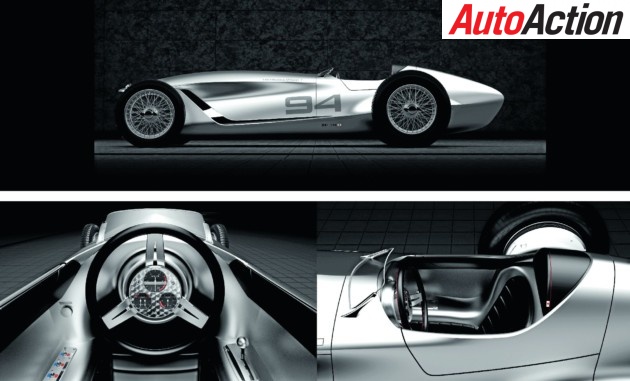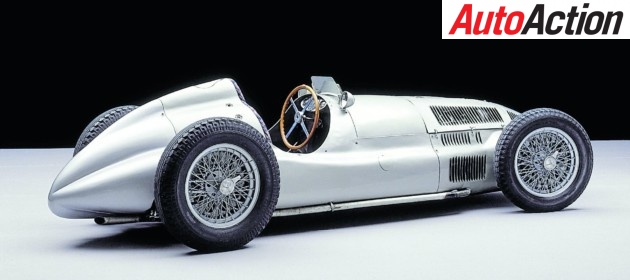SILVER… AND BEYOND – INFINITI PROTOTYPE 9


Infiniti’s Prototype 9
Infiniti is not a brand often connected to motor racing – but the Prototype 9 turns back the clock in an interesting way
IMAGINE, IF you will, you have the means to make a recreation of an historic racing car. One that evoked memories of another age – one of the sport’s greatest. And that you had access to the finance to get the car designed and built – and, possibly, with an international automobile manufacturer.
And a time machine.
Car companies generally do not do those kinds of things. But Infiniti has done it, with the Prototype 9, unveiled last week in California.
The idea behind the car was this; what if there was a car built years ago, to the highest standards, and never seen by anyone other than those who built it?
“We discussed the idea of ‘chancing’ upon an unrecognised race car, hidden away for decades in a barn, deep in the Japanese countryside,” explains Alfonso Albaisa, Senior Vice President, Global Design for Infiniti.
“We wanted to explore what this looked like, what it would have been made of.
“Open-wheeled racers of the age were beautiful machines, elegant and powerful and with a wonderful purity of purpose.
“It’s an automotive fantasy, but the notion captured our imaginations enough to put pencil to paper.
“As we started work on a physical model, word spread beyond the core design team, and other departments started checking in and offering assistance. Eventually, the production team became aware of the project – and brought with them the desire and skills to build it.”

Infiniti’s Prototype 9
While the design was being thought out, and clay models started to take shape inside the Infiniti Design Studio in Atsugi, Japan, in the Kanagawa Prefecture, word seeped into other parts of Infiniti and Nissan that something a little different was taking shape.
A team of powertrain engineers proposed that the car should be powered by a new EV powertrain, one not yet seen on a production vehicle. The result is a prototype electric motor that produces 120kW and 320Nm of torque and drives the rear wheels.
In one fell swoop there was no need to include a fuel system or develop a bespoke engine suitable for the period represented.
With no gearbox (the motor is paired with a single-speed transmission) the Prototype 9 has a top speed of 170km/h and sprints from 0-100km/h in 5.5 seconds.
With its 30kWh high-voltage battery, the car has a maximum EV range of 20 minutes under heavy track use.
Those specifications probably go some way towards answering the questions of why the Prototype 9 was built – and why it was unveiled now.

Infiniti’s Prototype 9
Next month Nissan is expected to show its new Leaf electric car to the world for the first time and expectations are that those engine and drivetrain specs are quite close to what powers the P9…
With the powertrain in place, the project moved to a secluded section of the Nissan Research Center, Oppama, just outside Yokohama, where a team of Takumi – Nissan’s master craftspeople – was gathered to create a one-off vehicle.
The bodywork is hand-beaten, and made from steel panels that reflect Infiniti’s signature design elements, such as the double-arch grille, ‘shark gills’ aft of the front wheels, a single-crease hood, and sharp lines that stretch from front to rear.
Inside the body is a steel ladder frame, and at each corner are custom-made 19-inch centre-lock wire-spoked wheels, which are even fitted with period cross-ply competition tyres.
The cockpit is wrapped in black leather with red contrasting stitching, with subtle Japanese flags stitched into the integrated headrests of the deep single bucket seat.
The steering wheel rotates around a fixed central hub finished in turned aluminium, which houses the instrument gauges.
By the end of the project hundreds of people had worked on the Prototype 9, and the result was revealed last week at Pebble Beach. Such a car is not something that is commonly produced by global auto manufacturers, but this one shows there is an enthusiastic heart beating at Infiniti.
And why is is called the ‘9’?
In Japanese, ‘9’ is pronounced ‘Ky-uu’ – which is very close to the English pronunciation of ‘Q’ – the prefix used for all of Infiniti’s production cars…
ONE OF A KIND

Mercedes’ W165 Grand Prix winning car from 1939
IF THE Prototype 9 is interesting, one of the cars that inspired it is downright fascinating.
There were more important things to worry about in late 1938 than motor racing – but worrying about it was what some at Mercedes-Benz did. The Tripoli Grand Prix was one of the sport’s biggest races and Mercedes had dominated it, winning three times in four years. The streak of Rudi Caracciola in 1935 and Hermann Lang in 1937 and ‘38 was broken by Achille Varzi, who triumphed for Auto Union in 1936.
The race may have been held in Libya, but the Italians were in charge, so for the ‘39 event they made a change to the regulations. Only cars of less than 1.5-litre engine capacity would be allowed to race.
Mercedes’ W154, which had dominated racing in 1938, had a supercharged 3-litre V12 engine, so that would not make the trip south.
Surely, no one would make a car for just one race. Surely the small Italian cars would now triumph.
But Mercedes did the former. And the Italians didn’t do the latter.

Mercedes’ W165 Grand Prix winning car from 1939
In just seven months, the W165 and its 1.5-litre V8 engine (a first for the company) was designed, built and developed, in total secrecy. The engine produced 187kW (254hp) at 8000rpm, and revved to 9000 rpm. That gave the car a top speed of
272km/h.
Four were built and at its first test Lang was thrilled.
“Goodness me,” he wrote in his autobiography, “the little athlete could go! You’d hardly got into one gear before you were switching to the next.”
The result was… predictable. Luigi Villoresi, driving a Maserati, was fastest in qualifying but Lang was alongside him – and that was the last anyone saw of him. By mid-race the German was 90 seconds ahead of teammate Caracciola, and they finished in that order. Emilio Villoresi, driving an Alfa Romeo, was third, almost 10 minutes behind the winner.
The next race was in Pau and Lang won that too – in a W154. The little car never raced again. Mercedes-Benz won every race that season, including the Swiss GP at Bern on August 20.
Less than two weeks later, World War II started and motor racing would not seem important again for quite a long time.
Pick up the latest issue of Auto Action magazine for our most recent features. Also follow us on social media Facebook, Twitter and Instagram news between issues.


